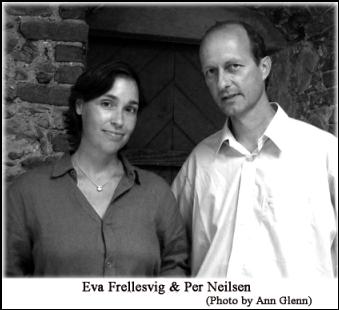Early Schooling in Denmark and her Colonies
(A presentation by Eva Frellesvig, summarized by Chuck Pishko)
We were honored to have Professor Per Neilsen and his wife, Eva Frellesvig, as our speakers at the December 2, 2005 meeting. Per Neilsen teaches Caribbean history at the University of Copenhagen, with his main interest in the Danish West Indies. Eva Frellesvig is an assistant at The Fredricksborg Museum in Copenhagen, which houses the National History Museum and the Portrait Gallery.
Eva Frellesvig spoke on early schooling (1700 – 1850) in Denmark and her colonies. She is currently finishing her thesis on 18th century schooling in Greenland. Eva told the members that she was honored to be presenting her talk in such an historic setting as the Bethany School.

She began a fascinating around the world tour of Danish colonies beginning with Tranquebar on the southeast coast of India. This was a small early trading station. She moved on to the Gold Coast of Africa, Fort Christanborg, the Danish West Indies and Greenland.
Most early education was religious, both in assisting Lutherans in practicing their faith and bringing the Lutheran faith to the non-believers. In 1721, during the absolute monarchy of Frederick IV, he decreed that schools should be established on all royal estates in Denmark. By 1733 the rite of Confirmation was necessary for full citizenship, e.g. testifying in court, etc. Students of the enlightenment often say that the Danes embraced the movement even more so than the French. The 3 r’s; reading, writing, and arithmetic were instructional norms for everyone by 1814 and they soon spread to the colonies.
Here in the Danish West Indies, the Crown chose the German Moravian missionaries, with their extensive educational efforts, to lead its schools. Eva referred to Count Zinzendorf, Hans West and von Scholten as playing major roles in the schools. She also spoke of the original Dutch Creole and the eventual use of English in 1838. The German Moravians produced a population with the highest literacy rates in the Caribbean. A job well done!
Per Neilsen provided some wonderful insights into the life of John Wright. He was born enslaved on St. John in the 1700s, bought his freedom, moved to St. Thomas, became a master carpenter and builder, and was responsible for the building of our Cruz Bay Battery. Per’s research has brought much new and relevant information to light. And, because of its importance to the SJHS, we wish to provide a through synopsis of his presentation, which current newsletter deadlines will not allow. Therefore, we will complete this effort and share it with you in the upcoming January issue.
